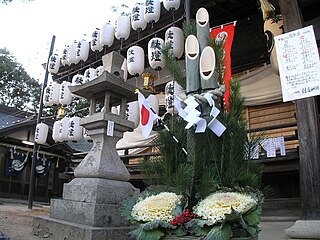Related Research Articles

The Yule log, Yule clog, or Christmas block is a specially selected log burnt on a hearth as a winter tradition in regions of Europe, particularly the United Kingdom, and subsequently North America. The origin of the folk custom is unclear. Like other traditions associated with Yule, the custom may ultimately derive from Germanic paganism.

Coppicing is a traditional method of woodland management which exploits the capacity of many species of trees to put out new shoots from their stump or roots if cut down. In a coppiced wood, which is called a copse, young tree stems are repeatedly cut down to near ground level, resulting in a stool. New growth emerges, and after a number of years, the coppiced tree is harvested, and the cycle begins anew. Pollarding is a similar process carried out at a higher level on the tree in order to prevent grazing animals from eating new shoots. Daisugi, is a similar Japanese technique.
Faggot, faggots, or faggoting may refer to:

Incense is aromatic biotic material that releases fragrant smoke when burnt. The term is used for either the material or the aroma. Incense is used for aesthetic reasons, religious worship, aromatherapy, meditation, and ceremony. It may also be used as a simple deodorant or insect repellent.

A campfire is a fire at a campsite that provides light and warmth, and heat for cooking. It can also serve as a beacon, and an insect and predator deterrent. Established campgrounds often provide a stone or steel fire ring for safety. Campfires are a popular feature of camping. At summer camps, the word campfire often refers to an event at which there is a fire. Some camps refer to the fire itself as a campfire.

A besom is a broom, a household implement used for sweeping. The term is now mostly reserved for a traditional broom constructed from a bundle of twigs tied to a stout pole. The twigs used could be broom, heather or similar. The song "Buy Broom Buzzems" from Northern England refers to both types of twig. From the phrase broom besom the more common broom comes. In Scotland, besoms are still occasionally to be found at the edge of forests where they are stacked for use in early response to an outbreak of fire.

Wassail is a beverage made from hot mulled cider and spices, drunk traditionally as an integral part of wassailing, an ancient English Yuletide drinking ritual and salutation either involved in door-to-door charity-giving or used to ensure a good cider apple harvest the following year.

The kallikantzaros is a malevolent goblin in Southeast European and Anatolian folklore. Stories about the kallikantzaros or its equivalents can be found in Greece, Bulgaria, Turkey, Serbia, Albania, Bosnia and Cyprus. Kallikantzaroi are believed to dwell underground but come to the surface during the twelve days of Christmas, from 25 December to 6 January.

A kadomatsu is a traditional Japanese decoration as yorishiro of the New Year placed in pairs in front of homes to welcome ancestral spirits or kami of the harvest.

The tradition of wassailing falls into two distinct categories: the house-visiting wassail and the orchard-visiting wassail. The house-visiting wassail is the practice of people going door-to-door, singing and offering a drink from the wassail bowl in exchange for gifts; this practice still exists, but has largely been displaced by carolling. The orchard-visiting wassail refers to the ancient custom of visiting orchards in cider-producing regions of England, reciting incantations and singing to the trees to promote a good harvest for the coming year. Notable traditional wassailing songs include "Here We Come a-Wassailing", "Gloucestershire Wassail", and "Gower Wassail".

The Yule goat is a Scandinavian and Northern European Yule and Christmas symbol and tradition. Its origin may be Germanic pagan and has existed in many variants during Scandinavian history. Modern representations of the Yule goat are typically made of straw.

The Apple Wassail is a traditional form of wassailing practiced in the cider orchards of southern England during the winter. There are many well recorded instances of the Apple Wassail in the early modern period. The first recorded mention was at Fordwich, Kent, in 1585, by which time groups of young men would go between orchards performing the rite for a reward. The practice was sometimes referred to as "howling". On Twelfth Night, men would go with their wassail bowl into the orchard and go about the trees. Slices of bread or toast were laid at the roots and sometimes tied to branches. Cider was also poured over the tree roots. The ceremony is said to "bless" the trees to produce a good crop in the forthcoming season. Among the most famous wassail ceremonies are those in Whimple, Devon and Carhampton, Somerset, both on 17 January.

In India, incense sticks, also called Agarbatti, are a large part of the economy and many religions in the region.

Julebukking is a Christmas tradition of Scandinavian origin.

The badnjak, also called veseljak, is a tree branch or entire tree that is central to Serbian Christmas celebrations. It is placed on a fire on Christmas Eve and its branches are later brought home by worshipers. The tree from which the badnjak is cut, preferably a young, straight and undamaged Austrian oak, is ceremonially felled early on the morning of Christmas Eve. The felling, preparation, bringing in, and laying on the fire, are surrounded by elaborate rituals, with many regional variations. The burning of the log is accompanied by prayers that the coming year brings food, happiness, love, luck, and riches. The log burns on throughout Christmas Day, when the first visitor strikes it with a poker or a branch to make sparks fly, while wishing that the family's happiness and prosperity be as abundant as the sparks. As most Serbs today live in towns and cities, the badnjak is often symbolically represented by a cluster of oak twigs with brown leaves attached, with which the home is decorated on Christmas Eve.

A wish tree is an individual tree, usually distinguished by species, position or appearance, which is used as an object of wishes and offerings. Such trees are identified as possessing a special religious or spiritual value. Postulants make votive offerings in hopes of having a wish granted, or a prayer answered, from a nature spirit, saint or goddess, depending on the local tradition.

Père Fouettard is a character who accompanies Saint Nicholas on his rounds during Saint Nicholas Day dispensing lumps of coal and/or beatings to naughty children while St. Nicholas gives gifts to the well behaved. He is known mainly in the far north and eastern regions of France, in the south of Belgium, and in French-speaking Switzerland, although similar characters exist all over Europe. This "Whipping Father" was said to bring a whip with him to spank all of the naughty children who misbehaved.
Serbian Christmas traditions are customs and practices of the Serbs associated with Christmas and a period encompassing it, between the third Sunday before Christmas Day and Epiphany. There are many, complex traditions connected with this period. They vary from place to place, and in many areas have been updated or watered down to suit modern living. The Serbian name for Christmas is Božić, which is the diminutive form of the word bog ("god"), and can be translated as "young god". Christmas is celebrated for three consecutive days, starting with Christmas Day, which the Serbs call the first day of Christmas. On these days, one is to greet another person by saying "Christ is Born," which should be responded to with "Truly He is Born," or in Serbian: "Hristos se rodi" – "Vaistinu se rodi".
The folklore festival known as farchie is held each year in Fara Filiorum Petri, a communal capital of about two thousand people located in the Province of Chieti in Italy's central Abruzzo region. The farchie ritual has its roots in the 1799 French invasion of Abruzzo. During this time the French forces had surrounded the town of Fara. Miraculously, Saint Anthony of Abate is said to have appeared and as he did the oak trees surrounding Fara burst into roaring flames. Seeing this, the French soldiers fled Fara thus sparing the town from certain destruction and ruin. In another version of this story the Saint appeared as a general and sent word to the French troops who were very near Fara on their way from Bucchianico towards Guardiagrele. Saint Anthony forbade the French from attacking Fara but they did not heed him and as they approached the nearby oak trees burst into flames thereby engulfing the hapless attacking forces. The first written records documenting the farchie date back to the year 1890.
The Broad was a folk custom found in the Cotswolds, an area of south-central England, during the nineteenth and early twentieth centuries. The tradition entails the use of a hobby horse with a bull's head that is mounted on a pole and carried by an individual hidden under a sackcloth. It represents a regional variation of a "hooded animal" tradition that appears in various forms throughout the British Isles.
References
- ↑ Ashen Faggot at the Oxford Dictionary of English Folklore Retrieved 26 June 2013
- ↑ Ashen Faggot Retrieved 26 June 2013
- ↑ Ashen Faggot Wassail at Mainly Norfolk Retrieved 26 June 2013
- ↑ Burning the Ashen Faggot Retrieved 26 June 2013
- ↑ Willey, G. R. (1983). "Burning the Ashen Faggot: A Surviving Somerset Custom". Folklore. 94: 40–43. doi:10.1080/0015587X.1983.9716254.
- ↑ "Delightfully weird and wacky festive traditions" (PDF). Devon County Council. Archived from the original (PDF) on 15 December 2018. Retrieved 4 March 2015.
- ↑ Ayres, Jack. Paupers and Pig Killers: The Diary of William Holland. p. 279. ISBN 0-86299-052-1.
- ↑ The traditional Christmas Ashen Faggot Retrieved 26 June 2013